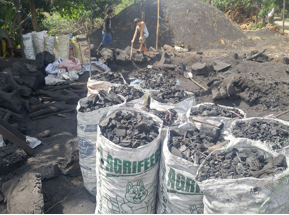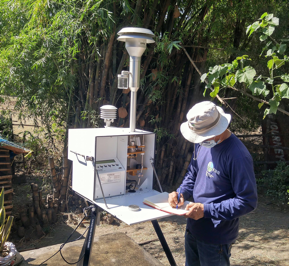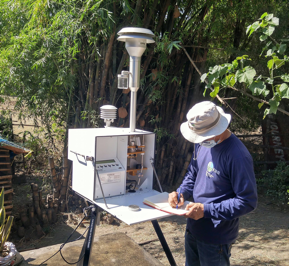Pangasinan: The town of Calasiao prides itself as the home of the famous native delicacy called puto (steamed rice cake). For many years, puto-making has been the town’s white gold for its economic contribution. In fact, the town annually celebrates the Puto Festival to highlight the gains of puto-making as one of its revenue earners.
However, there is another industry that is less celebrated but is just as important an income-earner for some people in Calasiao: charcoal-making. While the former continues to gain profit, the operation of the latter has been ordered stopped after more or less two decades of activity, due to alleged environmental and health hazards.
Elvira Diaz, a 46-year-old mother of five, is from Lumbang village and has been making charcoal, along with her husband, for almost 20 years as their primary source of living. She admitted that charcoal making had earned them much to sustain their family. One sack of charcoal costs 300 to 320 pesos. They can produce 100 sacks in a day, so that would be more than 30,000 pesos a day, less the capital expenses. “You have 10, 000 pesos as a profit,” she said. “That would be enough to sustain our children’s needs.”

Elvira and other charcoal-makers were forced to stop their enterprise when a petition was sent to the Local Government Unit of Calasiao. The petition asked that the municipality intervene because the industry was making people sick and that the operators like Elvira were already operating in large scale.
On February 7, 2017, Task Force “Oring” (Pangasinan word for charcoal), an inter-agency committee, implemented the final moratorium of charcoal production in two villages: Lumbang and Nagsaing. More than 50 families that depend on charcoal-making as a source of living were affected.
“We are affected from the charcoal making moratorium,” Elvira said. “We don’t have any other sources of living here in Lumbang village. I needed to cut the school allowances of my children as an effect.”
Ernesto Diaz, 54, a father of seven, from Nagsaing village, also complained about the stoppage of charcoal-making. While he stopped from charcoal making, he continues to pack charcoal that he buys from other towns to sell afterwards. He needed to do it to make both ends meet.

“We became even poorer when they stopped charcoal-production,” Ernesto said. “May they [LGU] fulfill their promise of helping us find an alternative source of living?”
Lilia Samonte, also a resident of Nagsaing, grumbled about having to feed their children some watercress and edible snails for meals now that charcoal-making has been stopped. “Unlike before, we can eat delicious food. Now, we eat “tuyo” (dried fish) instead of milkfish,” Lilia said.
Elvira, Ernesto and Lilia all await for the local government’s promise of livelihood assistance.
What went wrong?
Roberto Agsalud, Lumbang’s chieftain, admitted to have received a plethora of complaints from his constituents due to charcoal production. One third of the entire village population was affected, with nearby villages suffering the same. “Charcoal production draws ire from many residents, not only from our village, but also from nearby villages of Ambuetel and Dinalaoan,” Roberto said.
“The smoke is terrible; your lungs will be greatly affected,” Roberto said. “If you have asthma, you will suffer the effect more.”
Asked why it took them so long to finally put a halt to charcoal production, the chieftain said it was only now that complaints had escalated much. “There were already complaints before, but not as much as today,” Roberto said.
They even hinted to charcoal makers that they would lose their living if they will not regulate their production. They proposed for a rotational charcoal production among businessmen to ease the smoke effect but yielded negative compliance. “Those who have capital bought as much wood truckloads as funds permit to make charcoal,” Roberto said. “They became greedy.”
Prior to final closure, Ferdinand Mamaril, the head of Lumbang Charcoal Association, even agreed to follow environmental guidelines as suggested by the Community Environment and Natural Resources Office (CENRO) for their charcoal operation to continue. However, it was too late as the Task Force “Oring” decided to finally stop the operation citing environmental, health and economic reasons.
But threats of irresponsible charcoal-making are still evident. According to Task Force “Oring”, some affected businessmen have moved to other areas in Bayambang, Malasiqui, and San Carlos City. Some are subtly starting again at the backyard of the homes.
Affected charcoal-makers were given option to raise goat or cattle as an alternative source of living. The LGU has sought the help of the Department of Labor and Employment and Department of Trade and Industry for livelihood grant. The families which are into charcoal-making initially rejected the livelihood grants. They were not ready to embrace an alternative source of living. There hesitation can be attributed to the fact that income from cattle-raising will not be proportional to the income that they’re getting from charcoal production.
“We need to wait for another approval this time,” Albaño said. She assured that livelihood grants are now on the roll.
Reasons for closure
“Number one reason is health. The production area operates in a residential area, which is not allowed,” Janet Albaño, the newly designated municipal environment officer and head coordinator of Task Force “Oring” said. “Some are located in between houses, really very near residential houses.”
The Municipal Health Office cited that around 70% of the incidence of respiratory diseases in these two villages (Lumbang and Nagsaing) can be attributed to the smoke emissions from charcoal-making. Most affected are children and senior citizens.
Albaño and her team from the local government unit received indignant remarks from the affected charcoal makers. “They’re angry, cursed us, even the barangay officials received flak and threats not to be voted in the next election,” Albaño recalled as they implemented the moratorium for charcoal production.
Environmental effect was the second reason for the stoppage of the charcoal production. “This global warming has changed our climate, contributing to changes in the world,” Albaño said. “We need to bring down the level of carbon dioxide in the air.”
An environmental activist since 1997, Albaño fears that if they won’t stand on their ground of implementing the stoppage of the “irresponsible” charcoal making, the effect of global warming will be even more drastic.
Cordillera Ecological Center director Michael Bengwayan noted that charcoal production has devastating ecological effect. The most common cited impact is deforestation or the clearance of forest or woodland.
“Cutting trees can result in the loss of habitat for animal species, which can harm ecosystems,” Bengwayan said. “It will harm 70 percent of Earth’s land animal and plants that live in forests.” Since plants create oxygen and absorb greenhouses gases, large scale tree cutting contributes to global warming. He said that changing temperatures can alter which organisms can survive in an ecosystem.
Accordingly, charcoal making contributes in emitting greenhouse gases in the tropical system estimated at 71.2 million tons of carbon dioxide and 1.3 million tons of methane every year.
The Environmental Management Bureau from Region I also conducted a 24-hour air sampling test to Lumbang and Nagsaing. However, the result yielded negative. One local official, who requested anonymity, was dismayed at the timing when the air sampler test was conducted. “It’s just for compliance purposes,” the source said, claiming that EMB conducted the test when there was no one making charcoal. It was the period when the two-week moratorium was issued by CENRO to charcoal makers.

Albaño also discovered that despite regulating the issuance of permit to transport for woods to “cook”, such permits were being recycled. “One transport permit, one single use. That’s the rule,” she said. “What is happening, however, is that they [businessmen] photocopy the permits so they can bring as many truckloads of woods as possible in a day.” She lamented some loopholes conducted before and assured that it won’t happen again under her watch.
Aside from environmental and health reasons, the charcoal production in Calasiao only serves its capitalist businessmen and the families dependent on it. According to the town’s treasurer and business economic enterprise officer Chermel Poserio, not a single charcoal maker has a business registration. Poserio said they do not pay taxes to the local government unit as compared to puto-makers. Last year, the LGU collected P273,750 from cash tickets of 25 registered puto stalls, and P105,975 from business permits. The amount even excludes the personal income of individual and household puto-makers.
Responsible Charcoal Production
Bengwayan said that charcoal production can be a legitimate source of living if done in a more environment-friendly way. Aside from conducting the process away from residential places, he suggested that charcoal makers should establish fast-growing trees in woodlots that coppice or regrow easily, and the method of producing charcoal follows the ICPS (Improved Charcoal Production System).
“The efficiency of traditional charcoal production method is about 10%-22% (calculated on using oven-dry wood with 0% water content) while the efficiency of the ICPS is approximately 30%-42%,” Bengwayan explained. “As compared to traditional carbonization processes, the ICPS reduces emissions to the atmosphere by up to 75%.”
The ICPS works in two different phases. The first phase works like a traditional kiln; however, waste wood is burned in a separate box to dry the wood. The second phase involves the burning of harmful volatiles in a hot ‘fire chamber’, meaning all resulting emissions are cleaner with reduced volatiles. “The heat gained by flaring the wood gazes is used and recycled to accelerate the carbonization process,” Bengwayan explained. “Unlike traditional methods, ICPS can complete a carbonization cycle within 12 hours.”
Moving Forward
“Stop it while it is still small because once they find out that the business can thrive, authorities would have difficulty stopping it,” Albaño warned as she believes that irresponsible charcoal production exists in all other parts of the country.
Albaño recommends a strict monitoring from the issuance of permit to cut and transport woods, and the vigilance of residents to report immediately to authorities any irresponsible charcoal production they notice.
Bengwayan also promotes continuous re-greening by way of planting trees. Some trees grow slowly (20-30 years to reach full size), while others are fast growers (10-15 years).
“One and a half hectare of forest absorbs six tons of carbon dioxide and puts out four tons of oxygen. This is enough to meet the annual needs of 18 people,” he said.
However, until the needs of Elvira, Ernesto and Lilia remain unmet, they will look for ways to subsist, as far as getting their hands black and dirty again. The local government must fulfill its promise to assist affected residents by way of livelihood assistance, and prove to them that there are better ways to live outside irresponsible charcoal production. #
P.S.: This story was produced for PECOJON- Philippines; need to update for news development.
